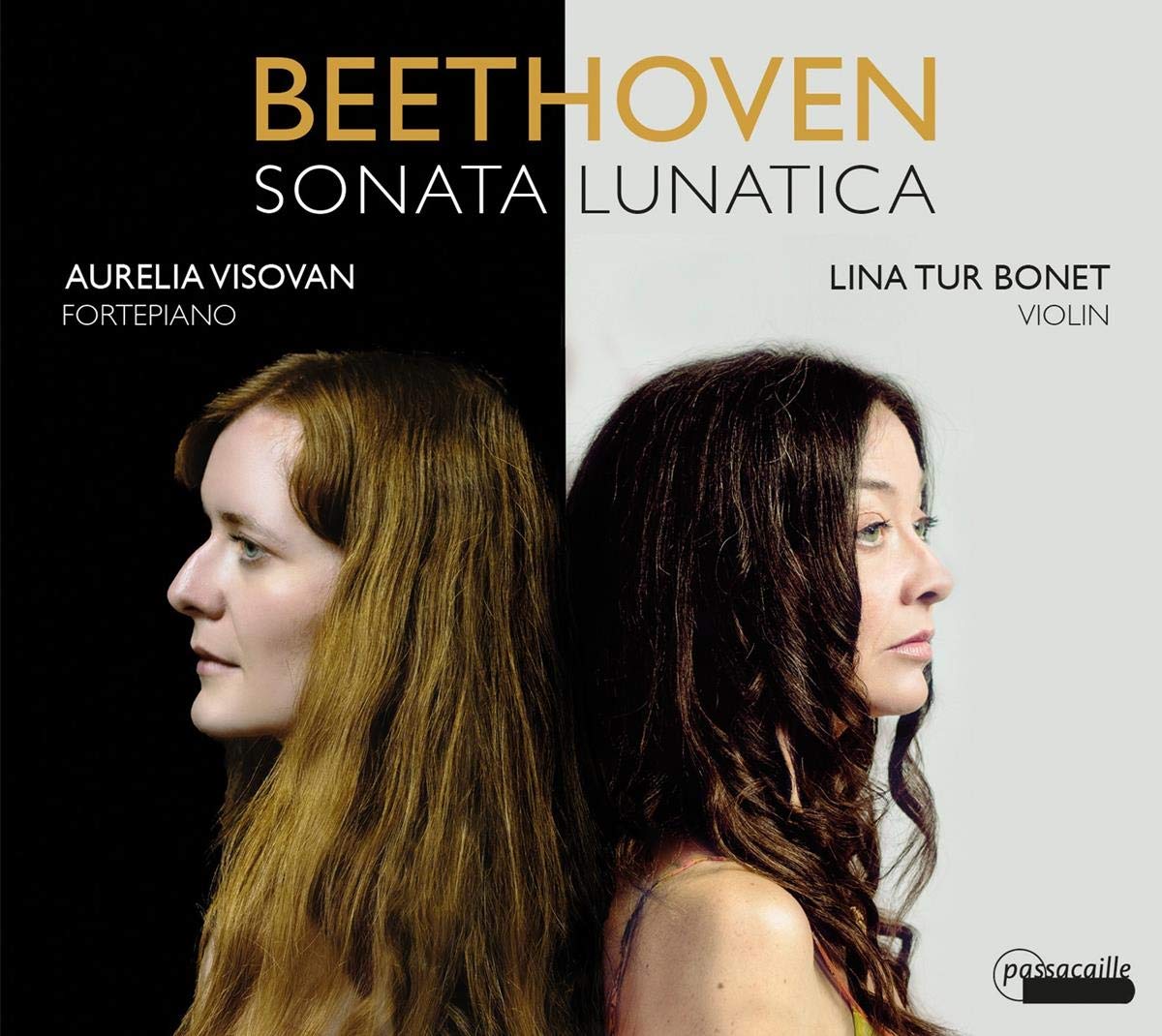Ludwig van Beethoven
Sonata for Piano and Violin No.10 in G major, op.96, “The Cockcrow”
Media Review / Comparison
2012-02-19 — Original posting (on Blogger)
2013-03-02 — Updates
2013-07-15 — New standard layout applied
2014-10-31 — Re-posting as is (WordPress)
2015-03-08 — Re-added audio example
2016-06-23 — Brushed up for better readability
2021-04-24 — Comparison table; recording with Lina Tur Bonet & Aurelia Vişovan; layout enhancements
Table of Contents
Introduction
This is another note on the recordings of Beethoven’s sonatas for piano & violin in my music collection, about the sonata in G major, op.96, “The Cockcrow” — references to the CDs are given at the bottom of the respective section, or in one of the related postings, or see the summary on the postings covering Beethoven’s Sonatas for Piano & Violin.
Below you find my comments on the recordings that I have for the Sonata for Piano and Violin No.10 in G major, op.96, “The Cockcrow”, by Ludwig van Beethoven (1770 – 1827). The surname is used in anglo-saxon countries only — it is definitely not Beethoven’s. Here’s a short list of the recordings in this comparison, in alphabetic order:
- Renaud Capuçon & Frank Braley (2009)
- Isabelle Faust & Alexander Melnikov (2008)
- Arthur Grumiaux & Clara Haskil (1957)
- Gidon Kremer & Martha Argerich (1995)
- Yehudi Menuhin & Wilhelm Kempff (1970)
- David Oistrakh & Lev Oborin (1962)
- Itzhak Perlman & Vladimir Ashkenazy (1975)
- Lina Tur Bonet & Aurelia Vişovan (2020)
Violin Sonata No.10 in G major, op.96, “The Cockcrow” — The Movements
The movements in this sonata are
- Allegro moderato (3/4)
- Adagio moderato (2/4)
- Scherzo: Allegro (3/4) — Trio (3/4)
- Poco Allegretto (2/4) — Adagio espressivo (6/8) — Tempo I (2/4) — Allegro
The (measured) metronome numbers are approximate values only.
Comments on the Interpretations
Yehudi Menuhin, Wilhelm Kempff (1970)
Beethoven, The Complete Violin Sonatas, Vol.II: Sonatas opp.30, 47, 96
Yehudi Menuhin, Wilhelm Kempff
DG 459 436-2 (stereo, 2 CD); ℗ 1970

Yehudi Menuhin and Wilhelm Kempff (1970) — for general comments see op.30/1
Comments on the Performance
I. Allegro moderato
11’02”; 1/4 = 112
Violin: articulation not very good; the sf are too soft, almost not done. Then exposition starts slower — this enforces a slowdown when returning to the beginning for the repetition, which to me wasn’t done in the best possible way. The pedaling in the Coda is rudimentary, does not follow Beethoven’s notation.
II. Adagio moderato
6’20”; 1/4 = 52
Good tempo; in the espressivo, the violin is rather superficial, often coarse. One of the traps in this movement are those crescendi to a lead tone which is a fourth above the preceding note: on the violin, this higher note naturally sounds much louder — so, even if there is a crescendo, that lead tone must be taken back: Menuhin falls into this trap just about every time.
III. Scherzo: Allegro — Trio
1’54”; 1/4 = 198 — 198 (Trio)
Coarse, rough — a Scherzo??
IV. Poco Allegretto — Adagio espressivo — Tempo I — Allegro
9’27”; 1/4 = 84 (theme)
Somewhat superficial (dolce taken as semplice?); Menuhin holds the fermatas in the Adagio part (during the piano Cadenza) — formally correct, though sounds a bit odd towards the end.
| Recommendation: | No |
| Rating: | 2.0 (1 / 3 / 2 / 2) |
David Oistrakh, Lev Oborin (1962)
Beethoven: The Sonatas for Piano and Violin (opp. 12, 23, 24, 30, 47, 96)
Philips 468 406-2 (stereo, 4 CD); ℗ 2001

David Oistrakh and Lev Oborin (1962) — for CD information and general comments see op.12/1
Comments on the Performance
I. Allegro moderato
10’38”; 1/4 = 116
The tone in this recording — especially with the violin — is fairly dull, unfortunately (the violin rarely reaches more than a mf), the interpretation in general is OK, the piano part diligent and attentive (though the pedaling in the Coda is not entirely accurate).
II. Adagio moderato
6’27”; 1/4 = 46
Very slow, but also subtle, melancholic, singing, introverted, almost serene.
III. Scherzo: Allegro — Trio
2’05”; 1/4 = 225 — 210 (Trio)
Too heavy, too slow — I’m missing the Scherzo character.
IV. Poco Allegretto — Adagio espressivo — Tempo I — Allegro
8’25”; 1/4 = 98 (theme)
The violin sounds very modest here (not sure how much of this is the recording, and what is the violinist). The piano is good, though a bit handsome. Like Menuhin, Oistrakh holds the two fermatas in the Adagio, though with more diligence.
| Recommendation: | No |
| Rating: | 2.5 (2 / 3 / 2 / 3) |
Arthur Grumiaux, Clara Haskil (1957)
Beethoven: Violin Sonatas, Complete (opp. 12, 23, 24, 30, 47, 96)
Brilliant Classics 93329 (mono, 3 CD); licensed from Decca

Arthur Grumiaux and Clara Haskil (1957) — for CD information and general comments see op.12/1
Comments on the Performance
I. Allegro moderato
9’29”; 1/4 = 124
The violin dominates this recording; not very transparent, unfortunately.
II. Adagio moderato
5’41”; 1/4 = 54
The piano part is very good — unfortunately, the violin is way too close to the microphone. Also, some of the 64th passages in the violin part are played with too much emphasis, too “literal”, too explicit — they should rather be embellishments, sort of a cadenza.
III. Scherzo: Allegro — Trio
1’39”; 1/4 = 270 — 234 (Trio)
The Scherzo is way too fast — and stiff, rough / coarse: I don’t see the humor in this piece. The Trio is slightly better, but also too fast; it loses all detail & subtlety.
IV. Poco Allegretto — Adagio espressivo — Tempo I — Allegro
8’24”; 1/4 = 96 (theme)
Grumiaux excels with his beautiful, dense tone (which he was famous for!) — but he dominates the entire movement, even where the violin part clearly is an accompaniment. The two fermatas in the Adagio part are played by the piano alone — as if they were placed on a break in the violin part.
| Recommendation: | No |
| Rating: | 2.8 (3 / 3 / 2 / 3) |
Itzhak Perlman, Vladimir Ashkenazy (1975)
Beethoven: The Violin Sonatas, Complete (opp. 12, 23, 24, 30, 47, 96)
Itzhak Perlman, Vladimir Ashkenazy
Decca 421 453-2 (stereo, 4 CD); ℗ 1974 / © 1988

Itzhak Perlman and Vladimir Ashkenazy (1975) — for CD information and general comments see op.12/1
Comments on the Performance
I. Allegro moderato
10’34”; 1/4 = 116
Good tempo, good pedaling in the Coda, sometimes a bit loud, coarse (rarely serene), Perlman’s nervous vibrato is irritating!
II. Adagio moderato
6’40”; 1/4 = 43
At this tempo, the melody is vastly overstretched; the p in the piano part is not very subtle.
III. Scherzo: Allegro — Trio
2’02”; 1/4 = 216 — 200 (Trio)
The Scherzo is OK, but a bit heavy. I like the dance character in the Trio.
IV. Poco Allegretto — Adagio espressivo — Tempo I — Allegro
8’46”; 1/4 = 98 (theme)
Good, lively, sometimes a bit “handsome”. Perlman sometimes (unnecessarily) interprets “intense” on long notes as strong vibrato.
| Recommendation: | Maybe for the last movement? |
| Rating: | 3.0 (3 / 2 / 3 / 4) |
Renaud Capuçon, Frank Braley (2009)
Beethoven: Complete Sonatas for Violin & Piano (opp. 12, 23, 24, 30, 47, 96)
Virgin Classics LV 7873 (stereo, 3 CD); ℗ / © 2010


Renaud Capuçon and Frank Braley (2009) — for CD information and general comments see op.12/1
Comments on the Performance
I. Allegro moderato
10’41”; 1/4 = 116
They are fairly close to the notation, a good interpretation in general. In the middle of the exposition the piano has eighths triplets in the right hand, along with eighths in the left hand — the triplets are played inégales, almost like eighths followed by two sixteenths. This per se might be debatable — but then the violinist should do the same in the following bars — which he doesn’t. The pedaling in the Coda is not quite accurate (holding the entire bars, but not the long stretch over three bars).
II. Adagio moderato
5’48”; 1/4 = 50
Very good, singing in the violin, with excellent dynamic control, harmonious, subtle, serene, calm, with moderate vibrato only (fortunately!).
III. Scherzo: Allegro — Trio
2’05”; 1/4 = 210 — 180 (Trio)
Too “kind”, too smooth, too little sf, too little humor; the Trio is slightly better.
IV. Poco Allegretto — Adagio espressivo — Tempo I — Allegro
8’38”; 1/4 = 92 (theme)
The piano is not always very accurate in the articulation — almost a bit sloppy. Could have more expression: too uniform and simple. On the other hand, the instrument balance is fairly good here.
| Recommendation: | Perhaps one of the better conventional performances |
| Rating: | 3.2 (3 / 4 / 3 / 3) |
Gidon Kremer, Martha Argerich (1995)
Beethoven: Violin Sonatas Nos. 9, 10 (opp.47, 96)
DG 447 054-2 (stereo); ℗ 1995

Gidon Kremer and Martha Argerich (1995) — for general comments see op.47
Comments on the Performance
I. Allegro moderato
10’34”; 1/4 = 116
Excellent phrasing, agogics, expressive, very nice dialog / team playing, detailed articulation — classes above all of the above interpretations!
II. Adagio moderato
6’29”; 1/4 = 42
Phrasing, articulation and dynamic control are OK, very expressive — unfortunately Kremer uses a very heavy vibrato; combined with the tempo (way too slow, over stretching the melody), this movement is (IMO) somewhat of a failure, unfortunately (at a high level, though).
III. Scherzo: Allegro — Trio
1’56”; 1/4 = 216 — 216 (Trio)
Excellent: I like the sforzati, the clumsy humor. The Trio combines humor and dance character. Interesting idea: they start the Coda a little slower, for a short final build-up.
IV. Poco Allegretto — Adagio espressivo — Tempo I — Allegro
8’23”; 1/4 = 94 (theme)
The articulation is closer to Beethoven’s notation than in any of the above interpretations. This performance is vivid, lively, emotional, has temperament — and humor: excellent! In the piano cadenzas, Argerich uses the holding pedal on the last scale — a very nice effect.
| Recommendation: | Yes |
| Rating: | 4.25 (5 / 3 / 4 / 5) |
Isabelle Faust, Alexander Melnikov (2008)
Beethoven: Complete Sonatas for Piano & Violin (opp. 12, 23, 24, 30, 47, 96)
Isabelle Faust, Alexander Melnikov
Harmonia mundi HMC 902025.27 (stereo, 3 CD + 1 CD/DVD); ℗ 2009

Isabelle Faust and Alexander Melnikov (2008) — for CD information and general comments see op.12/1
Comments on the Performance
I. Allegro moderato
11’29”; 1/4 = ca. 110
Once more an example of perfect musician partnership, finely tuned, transparent, and the violin has no problem in sounding through the piano part, even when playing ppp, sul ponticello!
II. Adagio moderato
5’24”; 1/4 = 53
Close to Capuçon / Braley in the basic characteristics — but with lots more phrasing, diction, agogics. Embellishments are played as what they are. Very expressive; very nice how the violin lets the melody flourish up to f, and as in the preceding movement, the violin has no problem being heard through the pain sound, also in the sotto voce parts (without vibrato, naturally), and when she uses an “airy bow” in the ppp.
III. Scherzo: Allegro — Trio
1’53”; 1/4 = 216 — 216 (Trio)
Close in character (and tempo) to Kremer / Argerich — but with much less effort: simply excellent!
IV. Poco Allegretto — Adagio espressivo — Tempo I — Allegro
8’49”; 1/4 = 92 (theme)
Compared to Martha Argerich, Alexander Melnikov may be less emotional / eruptive — on the other hand, he is even closer to Beethoven’s notation in his detailed articulation and phrasing. Isabelle Faust keeps the theme simple and cantabile, really like a folk song. In all these interpretations, this is the only one where I noted a distinct dynamic alteration in the first variation, where the two repeats are played softer, more p.
The other point that caught my attention were the two fermatas in the Adagio part. the violin does not play the fermatas — but instead, (similar to Argerich) Melnikov carefully uses the holding pedal in his cadenzas, hereby imitating the weak dampening of the fortepiano in Beethoven’s time: a very nice idea!
| Recommendation: | YES! |
| Rating: | 5.0 (5 / 5 / 5 / 5) |
Lina Tur Bonet, Aurelia Vişovan (2020)
Beethoven: “Sonata Lunatica” — Violin Sonatas Nos. 9, 10 (opp.47, 96)
Lina Tur Bonet, Aurelia Vişovan
Passacaille PAS 1086 (CD, stereo); ℗ / © 2020; booklet 24pp., en/de/fr

Lina Tur Bonet and Aurelia Vişovan (2020) — this is the latest addition to my Beethoven collection. I recently heard Lina Tur Bonet in a radio comparison, in a baroque piece. She clearly won that comparison, which made me curious. A few weeks later, I received an offer to review the above CD, listened to excerpts—and could not resist. So, I decided to append this recording to this 2012 comparison.
This comparison only deals with the Sonata No.10 in G major, op.96. For comments on the interpretation of the Kreutzer Sonata (A major, op.47) on the same CD see my separate comparison post on op.47.
The artists use the latest Bärenreiter edition (Beethoven, 2020) for their performance.
The Artists
Lina Tur Bonet
The Spanish violinist and conductor Lina Tur Bonet has started a steep career—first and primarily as baroque violinist on historic instruments. She appeared and recorded as chamber musician and soloist with a vast array of prominent artists. She also has performed in notable orchestras, and on top of that she has been concertmaster in numerous baroque formations all over Europe. Moreover, she also pursues a career as conductor, and she has founded her own chamber ensemble, MUSIca ALcheMIca. For full details see the artist’s biography. While she focuses on baroque music, her repertoire is actually much broader—her discography also included Music of the classical period, even music by Béla Bartók (1881 – 1945).
The Instrument
As far as I can see, this is Lina Tur Bonet’s first Beethoven sonata recording. She performs on a 1724 violin by Carlo Annibale Tononi (1675 – 1730, Bologna and Venice). Her bow is a classical (“Cramer”) model from around 1780, by John Dodd (1752 – 1839).
Aurelia Vişovan
The Romanian pianist, fortepianist, and harpsichordist Aurelia Vişovan (*1990) has been very successful as a soloist, both on the modern piano, as well as on historic instruments. As her biography states, Aurelia Vişovan is holding a teaching position for piano and chamber music at the Nuremberg University of Music. She also teaches harpsichord, fortepiano and basso continuo. In addition, she holds a Teaching Assistant position at the piano department of the University of Music and Performing Arts Vienna, and at the same time she pursues PhD studies in historically informed performance practice at the Gheorghe Dima Music Academy in Cluj-Napoca.
The Instrument
In this recording, Aurelia Vişovan performs on an instrument by Robert A. Brown, Oberndorf (near Salzburg), a replica of an instrument by Jacob Bertsche. It’s the same type of instrument as the one played by Kristian Bezuidenhout (*1979, see also Wikipedia) in a concert in Zurich on 2018-03-07. In that earlier concert report, I have also given a description of the instrument (compared to this recording, Bezuidenhout used fewer of the “bells and whistles”, though). Let me just reproduce the list of pedal functions from that earlier concert report:
- bassoon stop (a piece of silk or parchment over the bass strings creates a buzzing sound)
- keyboard shift (una corda, piano, for a softer sound)
- moderator (a piece of cloth or felt between the hammers and the strings darkens and softens the sound)
- double moderator
- damper control (sustain pedal)
- Janissary pedal (used to create cymbal-like sounds, as often encountered in Turkish military bands).
The “conventional” pedals (also found on modern instruments) are #2 and #5, a moderator function is found on most fortepiano instruments of the classical period.
Comments on the Performance
In some of the above interpretations, Beethoven’s op.96 feels like a transfigured composition by a composer at the end of his productive period—indeed, the atmosphere sometimes reminds me of the late Johannes Brahms (1833 – 1897)! True, it is clearly a work of Beethoven’s late period. However, Beethoven rarely ever feels nearly as transfigured, let alone resigned, as the late Brahms!
General Remarks
If you expect anything like a conventional, technically perfect and polished interpretation, you may be in for a shock: it is the most extraordinary performance that I have ever heard so far. For one, Aurelia Vişovan is exploiting (nearly) the full scope of that instrument (with the possible exception of the bassoon pedal). Then, and more importantly, Lina Tur Bonet takes the most radical, historically informed approach:
- she mostly performs without vibrato, and with a “light bow”, discharging notes (none of the dense / intense legato in conventional interpretations). However, as it suits the music, she highlights expressive motifs with a broad (but moderately intense, never nervous) vibrato.
- she frequently does left-hand position changes with a very noticeable portamento (often close to glissando!)—as an extra “ornament” / “feature”. For some listeners, it may take some getting use to for accepting this.
- Occasionally portamenti feel like the artist is “sneaking” into a new tone, occasionally giving the impression of borderline intonation.
- Lina Tur Bonet is definitely not aiming to achieve polished instrumental perfection: what counts is the expression, the emotion.
I. Allegro moderato
9’35”; 1/4 = 128
Amazing how Lina Tur Bonet produces expression in the shortest of motifs, down to single notes, starting with the trill in the initial / main theme! Her dynamics are highly expressive, the music so full of life, often almost rebelling. Aurelia Vişovan is fully “in tune” with the violinist—and the instrument is unmatched in its richness in colors. The pianist often arpeggiates chords, in order to make the tone gentler, keep it soft. And in the coda, she uses the moderator(s) to produce the darkest-possible of grumbling basses. Captivating, colorful, fascinating!
II. Adagio moderato
5’40”; 1/4 = 52
Here, Aurelia Vişovan combines arpeggiated bass chords and a very slightly delayed right hand, the moderator and una corda. On long notes, a swaying vibrato, portamenti and dynamics reinforce the expression, the emotion. The tempo is among the faster ones—yet, the interpretation remains highly serene, peaceful, calm—despite all the life in motifs and notes.
III. Scherzo: Allegro — Trio
1’44”; 1/4 = 270 — 240 (Trio)
Another amazement: the fastest of the performances in the Scherzo, just as Arthur Grumiaux—however, thanks to the short & light articulation and the accented rhythm, the music never feels rushed or pushed. Rather it retains the Scherzo character, and, of course, it is devoid of the clumsiness of the slow performances.
And the Trio! Light, joyful, dancing, playful—a true gem, marvelous!
IV. Poco Allegretto — Adagio espressivo — Tempo I — Allegro
8’20”; 1/4 = 115 (theme)
Among all the interpretations, this one must be the one with the richest agogics—and I say this in a movement that is—as a set of variations—already rich in variability! Unlike all others, already the Poco allegretto theme is devoid of comfiness, the Adagio part never retained. The Poco allegretto is faster than all others—which is easily explained with the lightness and the agility of the fortepiano. The clarity and poignancy of the triple- and quadruple-stop chords prior to the Adagio part is exceptional. And the agogics in the Adagio: marvelous—as if every note was carrying extra life and expression.
In the Allegro part, the sforzati, the liveliness almost go overboard—and where the fortepiano switches to octave movements (broken parallel octaves) in semiquaver movement (just prior to the fugato part in G minor), Aurelia Vişovan adds splashing Janissary beats to some of the sforzati—which makes the sudden pp for the short fugato insert all the more surprising.
One may find some of the portamenti excessive, maybe even occasionally irritating—to me, this is more than compensated by the mere fun and joy in this last movement. Plus, in the scope of this comparison, the fortepiano is simply unmatched, making all the pianos in the other interpretations look pale, if not colorless
| Recommendation: | YES: To me, a revelation, fascinating, an absolute must-have! It may not be a recording for everybody, though, see above—I love it! |
| Rating: | 5.0 (5 / 5 / 5 / 5) |
Comparison Table
I have put together a table comparing metronome (M.M.) rates and ratings. For the M.M. readings (notoriously approximate, as usual), blue indicates slower tempo, red indicates fast(er) tempo. The color scheme for the ratings (gray -> yellow -> green) should be obvious.
Addendum
If you are not an active pianist or violinist, you might want to follow this music using a pocket score — these typically come in two volumes:
- Sonatas op.12/1 – 3, op.23, op.24 —Find pocket score (Kalmus) on amazon.com (#ad) —
- Sonatas op.30/1 – 3, op.47, op.96 —Find pocket score (Kalmus) on amazon.com (#ad) —
While musicians, of course, prefer a full size score edition, such as Henle’s, also in two volumes:
- Sonatas op.12/1 – 3, op.23, op.24 —Find full score (Henle) on amazon.com (#ad) —
- Sonatas op.30/1 – 3, op.47, op.96 —Find full score (Henle) on amazon.com (#ad) —
The most recent recording (Lina Tur Bonet, Aurelia Vişovan) is relying on the latest Urtext edition:
- Beethoven, L., van. (2020). Sonaten für Klavier und Violine (C. Brown, Ed.; Bärenreiter Urtext, BA 9015, Vol. II). Bärenreiter Verlag, Kassel.
Acknowledgement
The CD with Lina Tur Bonet / Aurelia Vişovan was sent to me by Barbara Hoppe, NO-TE e.U. for reviewing.



















1 thought on “Beethoven: Violin Sonata No.10 in G major, op.96, “The Cockcrow””